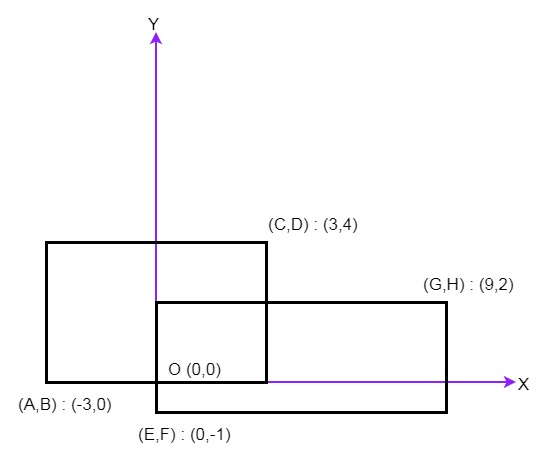
 Data Structure
Data Structure Networking
Networking RDBMS
RDBMS Operating System
Operating System Java
Java MS Excel
MS Excel iOS
iOS HTML
HTML CSS
CSS Android
Android Python
Python C Programming
C Programming C++
C++ C#
C# MongoDB
MongoDB MySQL
MySQL Javascript
Javascript PHP
PHP
- Selected Reading
- UPSC IAS Exams Notes
- Developer's Best Practices
- Questions and Answers
- Effective Resume Writing
- HR Interview Questions
- Computer Glossary
- Who is Who
Rectangle Area in C++
Suppose we want to find the total area covered by two rectilinear rectangles in a 2D plane. Here each rectangle is defined by its bottom left corner and top right corner as shown in the figure.

To solve this, we will follow these steps −
-
if C = E or A >= G or B >= H or D <= F, then
return (C – A) * (D – B) + (G – E) * (H – F)
Define an array h, insert A, C, E, G into h
Define an array v, insert B, D, F, H into v
sort h array and sort v array
temp := (h[2] – h[1]) * (v[2] – v[1])
total := temp
total := total + (C – A) * (D – B)
total := total + (G – E) * (H – F)
return total
Example(C++)
Let us see the following implementation to get better understanding −
#include <bits/stdc++.h>
using namespace std;
class Solution {
public:
int computeArea(int A, int B, int C, int D, int E, int F, int G, int H) {
if(C <= E || A >= G || B >= H || D <= F) return (C - A) * (D - B) + (G - E) * (H - F);
vector <int> h;
h.push_back(A);
h.push_back(C);
h.push_back(E);
h.push_back(G);
vector <int> v;
v.push_back(B);
v.push_back(D);
v.push_back(F);
v.push_back(H);
sort(h.begin(), h.end());
sort(v.begin(), v.end());
long long int temp = (h[2] - h[1]) * (v[2] - v[1]);
long long int total = - temp;
total += (C - A) * (D - B);
total += (G - E) * (H - F);
return total;
}
};
main(){
Solution ob;
cout << (ob.computeArea(-3, 0, 3, 4, 0, -1, 9, 2));
}
Input
-3 0 3 4 0 -1 9 2
Output
45

Advertisements
